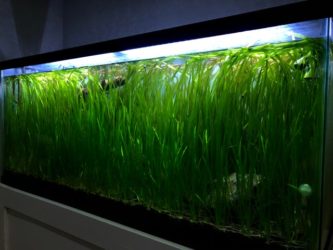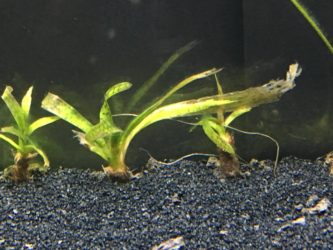Vallisneria Americana also commonly known simply as Jungle Val, water celery, tape grass or eelgrass is a freshwater plant that is hardy and can survive in diverse environments. The plant is one of the earliest aquatic plants that was introduced in aquarium plant hobby that has remained a favorite ever since it was discovered.
You will find various species of the plant most of which are common in the aquarium trade. If you are not well acquainted with the plant it may be very difficult for you to distinguish the plant from the many varieties similar to it. Fortunately, the Jungle Vals are so easy to find although other varieties are being sold in the market under misleading names.
Table of Contents
Jungle Val: A Quick Overview
Jungle Val (Vallisneria americana) is a hardy, fast-growing aquatic plant native to North America. It is commonly found in freshwater ponds, lakes, and streams. In the aquarium, Jungle Val is an excellent choice for providing cover and oxygen for fish, as well as helping to maintain water quality. It can be planted in the substrate or left floating in the water.
What does Jungle Val look like?

This plant resembles seagrass and will grow high to lengths that can be as high as several inches. The plant is known to grow even past the height of most tanks and is therefore usually ideal to be planted in the background of the aquarium.
Origin of This Freshwater Plant
Even though the name of the plant may suggest that it is exclusively native to the Americas it originates from diverse regions of the world such as Asia, Australia, and all parts of America.
The plant is known to prefer germinating in slow-moving water and therefore you will find it growing in lakes, ponds, and slow-moving streams. It grows in freshwater that is shallow and you will not find it growing in waters with depths of more than ten feet.
The other areas of natural occurrence that you can find this plant includes rivers and bays that have some level of salinity. This goes to show how tolerant this plant can be and how you can take advantage of it for use in your aquarium.
Jungle Val Care And Tank Setup

Jungle Val flower does not require a lot of care. If you place them in a tank, it can make your fish feel like they are living in their natural habitat. You can also add sand and gravel to your aquarium as substrate. They can grow in a moderate-light system, but their growth rate would be affected. Therefore, you will require a good light system with a well-maintained temperature around 64°F to 82°F.
Jungle Val Compatibility And Tank Mates
When it comes to Italian Val unnecessary jungle Val, Jungle Val has higher growth rates than Italian Val. Sometimes it grows up to 10 feet and requires trimming. Fishes can survive and enjoy swimming through these freshwater plants. Their stronger roots will keep the plant safe from big fishes in the same water tank.
Facts About Jungle Val
Jungle Val growth: They can reach your surface quickly under good lights. Its leaves must be underwater because the leaves will die off if they come out. Therefore, you need to cut them.
Survive in extreme conditions: Jungle Val can survive in all weathers. They can be grown on every continent except Antarctica.
Easy availability: You can buy jungle Jungle Val from the local shops in your market. They are the most common aquarium grasses found compared to other plants.
Is Jungle Val Right For You?
If you are an aquarium lover, you must bring these in your tank to increase the water’s oxygen level that helps fishes grow. They also use chemicals like ammonia for their growth.
Frequently Asked Questions
Does Jungle Val Need Root Tabs?
They can survive in both sand and gravel without root tabs. However, you can add root tabs if you want good growth and development. Root tabs are rich in iron and potassium; hence they are highly recommended for jungle Jungle Val.
Why Is Jungle Val Not Growing?
There can be several reasons like:
- Insufficient light
- Trimmed in the wrong way
- Lack of nutrients in your tank
Why Is Jungle Val Melting?
Sometimes melting occurs in aquarium plants. For example, in jungle Jungle Val, melting occurs because they need time to adjust to new water conditions. After adjusting, they will start growing automatically.
Planting in Your Aquarium
Jungle Val is a very hardy plant that easily adapts to several water conditions. You can easily plant it in hard and alkaline water and it will grow incredibly healthy. Research also has it that growing it in soft, acidic water will slow its growth. It is one plant that will also grow in brackish water albeit with a negative impact on the plant’s growth rate and its overall propagation.
Tips to caring for the plant

Here below are some important tips that you can follow to help you care for the plant successfully in your home aquarium:
- You can use gravel or sand as a substrate for planting the plant in an aquarium.
- Ensure that the crown of the plant is not submerged in water.
- Adding carbon dioxide into the aquarium is not necessary since the plant in its natural habitat is known to grow in shallow waters with very little carbon dioxide.
- You may need to add iron rich fertilizer that will help the plan to get nourished perfectly well.
- You should add fertilizer in the tank water every week particularly after performing the once-a-week water change.
- If you want the plants to perform best, provide high quality aquarium lighting to them such as the Marineland LED Lighting. Of course, the plants will still grow in low lighting but the growth rate will be much slower.
- Choose a high-quality LED light or even specialty light bulbs can do. Other good light options include; Fluorescent tubes and CFL.
- Never trim the leaves of the plant as this will make it easy for the plant to die of and start rotting in the tank and stale the tank water.
- If it is a must that you trim the leaves please use a very sharp trimming device that will not damage the plant’s leaves thus leaving it to die off easily.
- Let the plant grow in water that is hard and not too saline.
Propagation Process
Jungle Val usually reproduces by way of runners forming in the home aquarium then making roots then becoming an independent new plant. Ensure that the runners remain attached to the main plant until the leaves are entirely developed. Once the leaves have become fully developed you can then be removed from the main plant and then replanted on another portion of the aquarium. The timeline for the new plant to adapt after being transplanted is usually four weeks.
It is not easy for the plant to be reproduced by way of seeds when being grown indoors. The reproduction of this plant by way of seeds usually only occurs in its natural habitats such as ponds or streams. During the seed reproduction of the plant in the wild, there will be white female flowers of the plant that grow on the surface of the water. The male flowers of the plant which are smaller in size will then fertilize the female flowers through a process of pollination. This usually occurs when the male flowers are caught up between the female flowers. After pollination has taken place, seeds will then be formed in a structure appearing in the shape of long cylindrical pods.
Ideal uses of the plant
Jungle Val is a perfect plant to use in an aquarium with problematic fish that is aggressive. This is because the plant usually forms deep roots in the substrate and tough leaves making it difficult for the fish to damage. Use the plant in tanks where you have fishes like cichlids and other herbivorous fish. Even though there are fish species that may over time finally be able to destroy the plant, it is a good choice for aggressive fish compared to other varieties of aquarium plants.
